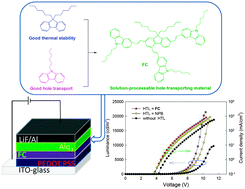A novel solution-processable, efficient hole-transporting material 2,4,7-tri[2-(9-hexylcarbazole)ethenyl]-9,9-dihexylfluorene (FC), composed of a fluorenyl core and triple-carbazolyl terminals, is successfully synthesized and well characterized. The FC is a thermally stable, amorphous material because of its aromatic and asymmetric structure. The highest occupied molecular orbital (HOMO) level of FC is −5.21 eV, as determined by cyclic voltammetry, implying its applicability as a hole-transporting layer (HTL) to promote hole injection. Furthermore, the FC could be deposited by a spin-coating process to obtain a homogeneous HTL film, more convenient and cost-effective than conventional NPB which must be deposited by vacuum vapor deposition. When fabricated as multi-layer OLED [ITO/PEDOT:PSS/HTL(25 nm)/Alq3(50 nm)/LiF(0.5 nm)/Al(100 nm)], the maximum brightness (21 400 cd m−2) and current efficiency (3.20 cd A−1) based on the FC are superior to those using conventional NPB as the hole-transporting layer. In addition, a homogeneous FC film is readily prepared by simple wet processes (spin-coating). Our results indicate that the FC is a promising optoelectronic material which is readily processed by wet methods such as spin-coating.

You have access to this article
 Please wait while we load your content...
Something went wrong. Try again?
Please wait while we load your content...
Something went wrong. Try again?


 Please wait while we load your content...
Please wait while we load your content...